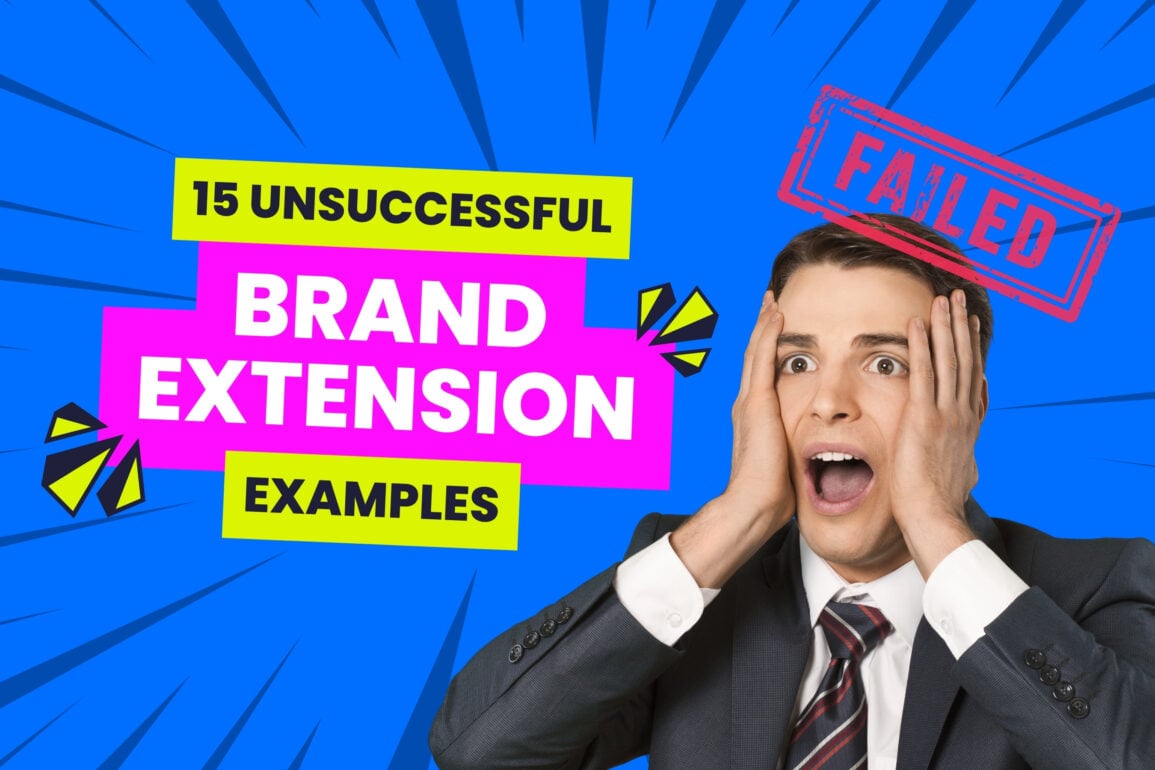Failed extensions: 15 unsuccessful brand extension examples

Extending your brand into a new line of products, or a new market can be an excellent way to increase sales and unlock new opportunities. Unfortunately, as the countless unsuccessful brand extension examples that have emerged throughout the years show – extensions aren’t always simple.
While we all know consistency is crucial to building brand equity, brands can’t afford to stand still. Companies need to constantly evolve to retain the attention and loyalty of their customers. Even if customers love your original product, they’ll eventually want something new.
A brand extension gives you a chance to explore new markets and categories, increasing your potential for sales. The trouble is, too many companies dive into a potential opportunity without much of a plan. That’s where a fantastic brand extension opportunity can turn into a flop.
The good news? You can learn from the mistakes of others. Today, we’re taking a closer look at some of the worst brand extensions of all time, and why they were such cringe-worthy failures.

What is a brand extension?
A brand extension is the process of using your existing brand or product name on a new product, or product category. Think of how Coca-Cola started with “original coke”, then moved onto attract new customers with flavored Coke drinks, Diet Coke, and Coke Zero.
The strategy allows a new offering to enter the market with the pre-established equity and awareness of the parent brand already attached to it. This means with a brand extension; you don’t always have to work as hard to raise awareness of your new offering.
There are various different ways to approach brand extensions, such as:
- Product extensions: When businesses offer secondary items on top of the products they already offer, which usually complement the primary product.
- Line extension: The art of adding extra “options” to a product line, such as a toothpaste company creating toothpastes for sensitive teeth, or dentures.
- Company expertise extension: When companies use a specific element of their expertise to create a product or service related to their skillset.
- Lifestyle extensions: When companies create a product or service that may not be related to their original product, but still appeal to customers with a specific lifestyle.
- Brand distinction extension: The art of a company known for its unique benefits using its prowess to serve a broader range of customers.
While a brand extension strategy benefits from access to your existing brand name, success is far from guaranteed. It’s all too easy to miss the mark because you don’t understand what your customers really want, or misinterpret what they love about your brand.
Unsuccessful brand extension examples
The worst brand extensions
There are plenty of great examples of brand extensions out there, from Google with its range of solutions for productivity like Google Docs and Sheets, to Dyson with its innovative line of hair care products. Unfortunately, there have been some major failures throughout history too.
Here are some of the most unsuccessful brand extension examples we’ve seen throughout the years, and why they were such astronomical failures.

1. Cadbury’s Instant Mashed Potatoes
Sometimes, when looking for brand extension opportunities, companies take an approach that’s just a little too broad. Cadbury might be known for creating food products, but the company is famous for its chocolate and candies.
When people see the Cadbury’s logo, they think “sweet”. Unfortunately, this meant when Cadbury decided to expand its product line with “instant mash”, the idea didn’t exactly get mouths watering.
Although the mashed potato wasn’t “chocolate flavored”, that’s what customers assumed it would be, leading to an overwhelming amount of confusion. No-one wants chocolate flavored spuds. Fortunately, the mashed potato product did eventually achieve some success.
However, it wasn’t until Cadbury launched the product under its own name “Smash”, that customers began to see the appeal.

2. Levi’s Tailored Classics
Virtually everyone is aware of the Levi’s brand its iconic red tag logo. Over the years, the company has built up a loyal customer base, thanks to its amazing brand reputation for delivering quality, comfort, and durability.
In the early 1980s, Levi’s already held a massive portion of the market share for things like jeans, so it wanted to branch out into a new category or two. One idea was to create a line of men’s suits.
Unfortunately, the new product line didn’t really appeal to new audiences (or existing customers), because Levi’s was already associated with casual, outdoorsy clothing. This unsuccessful brand extension example is a clear insight into how important it is to know your company’s USP.
If customers already love you for your durable clothing, branching out into an area like fancy suits probably isn’t a good idea.

3. Pillsbury Frozen Microwave Popcorn
This is another example of the worst brand extensions ever to emerge from a food company. Although Once again, the problem stemmed from a lack of audience research. Pillsbury was already an established brand name in the food industry when it decided to launch a new range of products.
The frozen microwave popcorn offering wasn’t entirely at odds with the brand’s image and reputation in the modern market, but it just didn’t seem to resonate well with customers.
Consumers were already more than happy with the non-frozen popcorn options on the market, and considered the “frozen” concept to be unnecessary. Ultimately, the product was just too hard a sell for Pillsbury, and they decided to drop the idea soon after launch.

4. Samsonite’s Outerwear
When you think “Samsonite”, what immediately springs to mind? If you’re familiar with the worldwide company, the answer is probably “luggage”. However, like many growing brands, Samsonite wanted a reputation for creating more than just suitcases and bags.
The organization decided to expand its product line, to produce more products associated with travel and exploration – including outwear. Though the clothing created by the brand was attractive, and well received by some new customers, it still turned into a bad investment for Samsonite.
The decision to start selling clothing, rather than focusing on what they did best (luggage), diluted the brand’s equity, and started driving away customers. As a result, Samsonite quickly abandoned the outerwear idea, and went back to the drawing board.

5. Arm & Hammer’s Deodorant
Ultimately, if you want to avoid ending up on a list of failed brand extensions, one of the first thing you need to do is ensure your new product makes sense. Unfortunately, Arm & Hammer seemed to miss this memo.
After experimenting with a few different types of brand extension strategies, the company had successfully extended its core product line into a range of laundry detergent, carpet deodorizers, and cat litter options. The problem happened when they flew a little too close to the sun.
Highlighting the benefits of their product for “odor neutralizing” purposes, Arm & Hammer decided to create a deodorant spray. Unfortunately, consumers weren’t convinced that a company known for its heavy duty cleaning products would create a good deodorant.
Customers couldn’t picture themselves actually using the product on their bodies, fearing it would be harsh on the skin, or somehow dangerous.

6. Colgate Kitchen Entrees
Considered one of the worst brand extensions of all time by branding strategists and consumers alike, Colgate’s Kitchen Entrees are a perfect example of how bad an extension strategy can be.
Though Colgate had done well with previous extensions in its brand strategy, involving selling various oral healthcare and toothpaste products, it made a massive mistake when it assumed its brand reputation would help it thrive in the food landscape.
Everything consumers knew about Colgate was linked to minty fresh breath and clean teeth. The brand’s reputation just didn’t work for a line of frozen entrees, such as Colgate beef lasagna.
The Colgate toothpaste company stretched a little too far with this product strategy, and paid the price. They quickly pivoted back to focusing just on tooth and oral care, however (thank goodness).

7. Cosmopolitan Magazine Yogurt
Imagine you’re running one of the world’s most successful magazine companies, targeted at women across the planet. Once your magazine becomes a major success, what do you do next? Branch into other forms of media, create a podcast, or launch a line of yogurts?
For some reason, Cosmopolitan chose the last option. The company assumed that its existing reputation for giving health, wellbeing and nutrition advice would cause customers to trust virtually any product it produced. Unfortunately, they were wrong.
As bad brand extensions go, the Cosmopolitan yogurt fiasco is one of the worst. Not only did customers not understand the reasoning behind the new product, but they were left questioning the ethics and mission of the larger parent brand.

8. Life Savers Soda
At a glance, candy and soda sound like a great mix. After all, both of these products are packed with sugar, and designed to give us a nice little energy boost after a long day. Unfortunately, while young kids might like the idea of drinking their candy, most consumers don’t.
When Life Savers decided to create a line of soda options matching the flavors of their popular candies, they assumed it would open up an entirely new revenue stream. Initially, the novelty of the product did attract a few sales.
Unfortunately, unlike all of the unsuccessful brand extension examples here, the idea eventually failed to truly take off. Customers saw the product as sickly, and most parents didn’t want to buy obviously sugar-laden drinks for their children.

9. Frito-Lay Lemonade
Here’s another unsuccessful brand extension example sure to leave a bad taste in your mouth. Frito-Lay, the company known for producing salty snacks and crisps, wanted to expand its target audience by moving into other areas of the food and beverage landscape.
They knew their target market already bought plenty of sodas and fizzy drinks alongside their products, particularly at supermarkets, so designing a drink of their own seemed to make perfect sense. The first new product to make its way onto shelves was lemonade.
Although the product itself didn’t get a lot of negative feedback from customers, it struggled to actually earn any cash. Consumers saw the “Frito-Lay” logo and assumed the drink would be salty or savory, just like the company’s well-established product offerings.

10. Crystal Pepsi
Pepsi is one of the biggest soda brands in the world, known by consumers all across the globe. While the company has achieved some incredible success over the years, it has also been responsible for some major branding and rebranding flops.
To keep up with its main competitor, Coca-Cola, Pepsi regularly produces new drink flavors and options for its consumers. In the 1990s, the company’s market research discovered consumers were looking for newer, healthier product options in the food landscape.
As a result, the team decided to create an uncolored version of Pepsi, with a citrus flavor. Unfortunately, customers associated Pepsi with the dark brown color of its drink, and were confused about the new product design.
They also rallied against the new flavors, as the citrus taste didn’t work well with the Pepsi taste most people had grown accustomed to.

11. Heinz Ez Squirt (colors)
Well-known food brand Heinz had some great success with its brand innovations in the early years. For instance, in 2000, the company introduced a new Ez Squirt product, that made it simpler to apply ketchup to food, without messing with a complex bottle.
To build on their existing product line, the company decided to have a little fun with their product collection, stripping the traditional red color of the condiment and replacing it with bright and vibrant shades of purple, pink, and green.
Initially, children loved the idea, and Heinz assumed it would become a massive success. However, parents ultimately avoided buying the product, because they assumed the high numbers of additives weren’t going to be good for their children’s health (or hyperactivity levels).
Eventually, Heinz removed the new product from shelves, leaving some children disappointed, but many parents relieved.

12. Harley Davidson Perfume
Harley Davidson is one of the most popular motorcycle brands worldwide, and for good reason. The company has achieved incredible success, not just by producing some amazing bikes, but also building a community around their brand.
Everything about the Harley Davidson brand is designed to appeal to people in search of a specific lifestyle, one driven by the quest for freedom. Since they wanted to position themselves of more of a lifestyle brand than an automotive company, branching into merchandise like perfume made sense.
The team thought the product would blend well with their existing accessories for motorcycle lovers. However, the perfume ended up being a disaster.
Like other major brand extension failures, Harley Davidson perfume didn’t appeal to new consumers, and it even alienated some of the existing lovers as the brand. Some people felt Harley Davidson were just looking for any excuse to “cash in” and make extra money.

13. New Coke
Another of the most unsuccessful brand extensions referenced by countless branding companies, New Coke was a flop for the history books. The trouble is Coca-Cola’s team did most of the things they should have done before extending their product line correctly.
They researched their audience, learned as much as they could about market needs, and designed a new “flagship product” based on numerous taste tests. While people loved the flavor of the new coke during the testing phase, the launch of the official product met significant backlash.
Customers felt betrayed and outraged, complaining that they had fallen in love with the original formula and flavor of the drink, and didn’t want anything to change.
The company was forced to quickly backtrack, re-introducing the “classic” Coke flavor, to eventually phase “new coke” out from supermarket stores. the simple lesson here is that even with plenty of research, brand extension mistakes are easy to make.

14. Bic Underwear
You’re probably familiar with Bic for their popular lines of disposable pens, lighters, and razors. The consumer goods company is best-known for creating products that are simple, affordable, and practical. However, one thing they’re not often associated with is underwear.
The new underwear line introduced by Bic was designed to coincide with its existing value proposition, offering customers a “disposable” alternative to standard underwear. The team thought the offering would appeal to a growing market of consumers for convenient hygiene products.
However, like many of the unsuccessful brand extension examples listed here, Bic underwear didn’t turn out to be a winner for the company. It clashed with the brand image and reputation of Bic, and consumers felt the item itself was just a waste of money.

15. Burger King Satisfries
Often successful brand extensions achieve great things because they respond to the changing needs of a specific audience. For instance, McDonalds earned more loyal customers after introducing healthy food products to its menu, to appeal to health-conscious consumers.
Burger King tried to take the same approach with its “Satisfries” product. These crinkle-cut fries promised all of the flavor of the original version of the product, without the extra saturated fat. It seemed like a great idea for the company, but it just didn’t pan out.
Ultimately, consumers felt the product wasn’t nearly as tasty as its alternative, and many felt the fries had a dry, tough texture. Eventually, Burger King banished the new fries from the menu, and went back to experimenting with different meal ideas.
Learn from these failed brand extensions
As the unsuccessful brand extension examples above go to show, a successful brand extension can be harder to navigate and implement than you might think. While extending your brand can have its benefits, opening the door to new potential profits and revenue, it’s easy to mess up.
Sometimes, the problem is that you simply haven’t researched your audience enough, to get an insight into what they actually want. Other times, your brand extension product is so far removed from your current product line, that it just doesn’t make sense.
There are even instances in which a brand extension failure can end up diluting your existing brand, and harming your reputation with your target audience.
While the examples above might have been disastrous for these wayward brands, they do offer a benefit to new and growing companies. Learn from the mistakes above, and make sure you take a strategic, thoughtful approach to your next brand extension.
Still uncertain? Reach out to Fabrik for help designing a brand extension strategy that elevates, rather than over-stretches your brand.
Fabrik: A branding agency for our times.
















